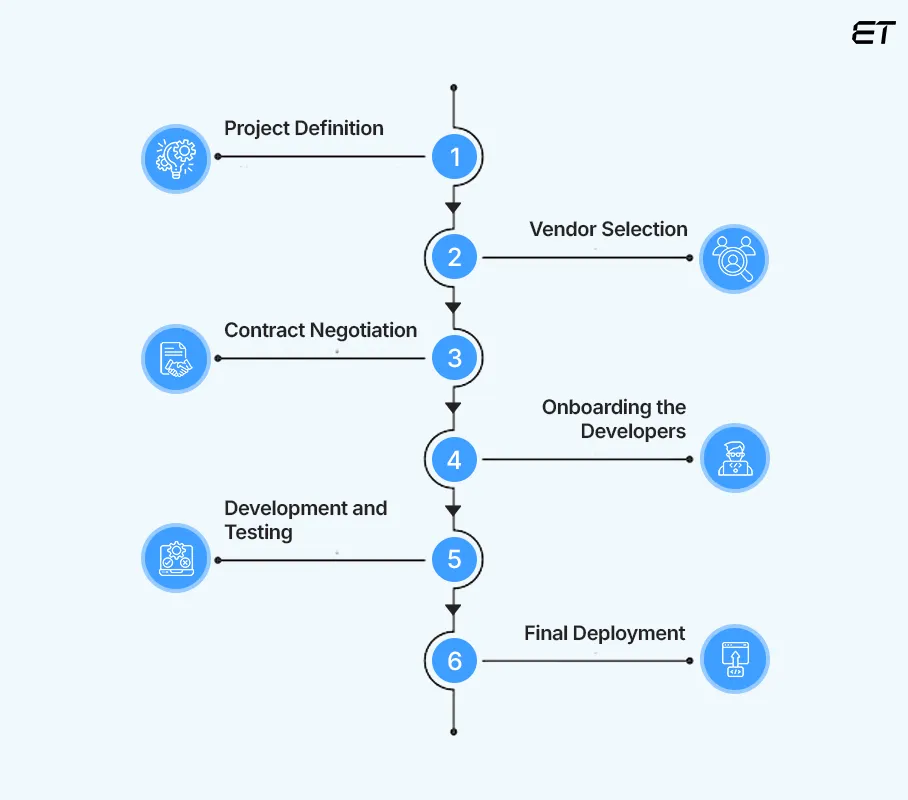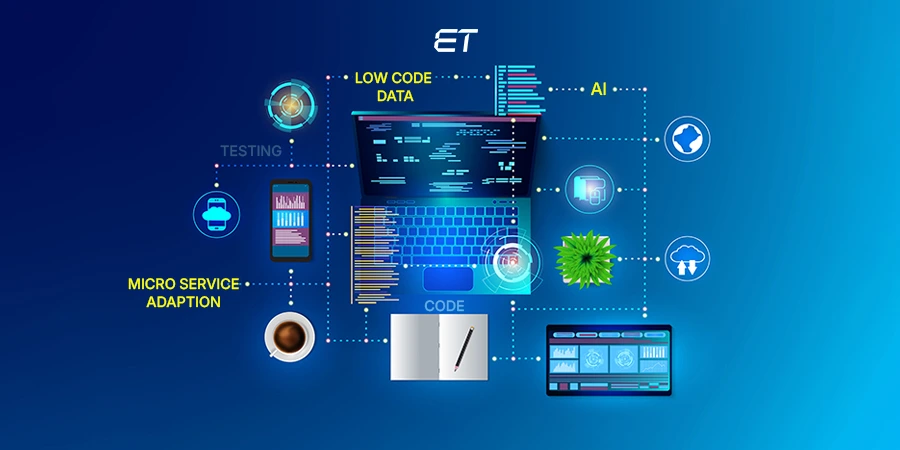
An Exhaustive Software Development Outsourcing Guide
Companies like Dropbox, Slack, Skype, and Alibaba have one thing in common. All of them leverage software development outsourcing for a variety of reasons.
You might even be contemplating the decision to outsource software development. After all, the outsourcing market is growing at an impressive compound annual growth rate of 8.48%.
Still, you need a thorough knowledge of this fruitful strategy to proceed with this tactic. Systematic execution of IT outsourcing leads to several benefits, such as accelerated product development, cost savings, risk mitigation, and rapid scaling.
However, the word ‘systematic’ is essential for experiencing all these advantages. So, read ahead to unravel the main elements of software outsourcing and embark on a journey of continuous progress.
Understanding Software Development Outsourcing

The term, ‘outsourcing’ is a combination of two words – ‘outside’ and ‘resourcing.’
This is a well-known business strategy since 1989 and implies hiring an external agency or company to perform specific tasks.
Software outsourcing is a similar term that focuses on hiring an IT company to develop a computer or web program.
| Definition: Software development outsourcing is the practice of hiring a third-party service provider to handle specific IT tasks or projects. These tasks can range from small-scale projects like developing a mobile app to building large-scale enterprise solutions. |
Many companies (established and new) outsource software development for the following reasons:
- Reduce labor costs
- Access specialized skills
- Accelerate development time
- Focus on core business activities
- Meet fluctuating project demands
Due to technological advancements, businesses are also hiring software programmers working in distant countries. They use tools for video meetings, instant communication, and collaboration.
This way, it becomes possible to keep track of software development activities in real-time.
We have a 22+ years of experience in outsourcing software development for global clients. Explore our expertise to connect.
How Software Development Outsourcing Works?

Outsourcing software development is a step-by-step process. Most companies follow a systematic approach that cover the following stages.
Stage 1: You Define Your Project Requirements

This initial step includes defining the goals and objectives of your software project. The document contains preliminary details as follows:
- Software functionalities
- Detailed specifications
- Non-functional requirements
- Desired tech stack
- Timeline and budget
After finalizing all these components, you shortlist several vendors or IT consulting firms that specialize in outsourcing. Your representative drafts a request for proposal form to assess the best option for your project.
Stage 2: You Choose the Most Suitable Vendor

In this step, you evaluate the best outsourcing companies for your project. To make the right decision, consider the following points:
- Experience
- Number of developers
- Tech stack knowledge
- Case studies
- Past and current projects
- NDA policy
- Outsourcing models
In addition to the above factors, it is vital to assess the vendor’s culture fit. Ensure that the outsourcing company has professionals who work with businesses based in your country.
Hiring developers who understand your work culture is a big plus point in this business strategy.
Looking to get a well-researched list of the top US IT consulting firms to outsource your requirements? Read our top-ranking blog today!
Stage 3: You Negotiate the Contract

The third step includes finalizing the outsourcing contract with the shortlisted vendor. In this stage, you need to affirm the following components:
- Service level agreement
- Non-disclosure agreement
- Intellectual property rights
- Payment terms
- Dispute resolution
It is critical to ensure proper coverage of all these facets to maintain a healthy professional relationship. This way, you augment the quality of software development outsourcing by building an honest and straightforward collaboration.
Stage 4: You Onboard the Outsourced Members

This step involves team formation. After completing all the formalities, it is crucial to share detailed project requirements and the existing codebase (if any) with the developers.
These aspects help the outsourcing partner to initiate your project with utmost confidence and clarity. At this stage, you should also decide on the communication channels. Some common modes are as follows:
- Emails
- Instant messaging
- Project management tools
- Video calls
Knowledge transfer is a vital part of software development outsourcing. However, the volume of information varies depending on your project’s status. For instance, if you are outsourcing a project from scratch, there will be no current codebases.
So, ensure you understand the level of details required to share while outsourcing software development.
Stage 5: The Team Develops and Tests the Software

The fifth stage is where the actual work takes place. The outsourcing company initiates your project using agile methodologies like Kanban or Scrum.
They conduct regular meetings, and the developers write codes to build the software or application with the desired functions. In this stage, the Quality Assurance experts implement rigorous testing activities to ensure the software’s proper operation.
As a client, you can oversee the technical team’s activities at this stage. Continuous communication is vital to making necessary adjustments in the initial phase. So, clarity is crucial in this software development outsourcing phase.
Need help developing or testing your software? Drop in your requirements and let’s start ASAP!
Stage 6: The Team Deploys the Software

The final step includes the following activities:
- Data migration
- Quality testing
- Data configuration
Before launching the software in your organization or the market, you can check the functionalities. The outsourcing partner also provides a dedicated team to handle ongoing maintenance, bug fixes, and seamless technical support.
One essential point to consider is choosing a reliable IT outsourcing company. The following section will explain the main factors to focus on when selecting such a vendor.
How to Choose a Reliable Partner to Outsource Software Development?
Seven factors define the choice of a trustworthy outsourcing company. Consider the following points:
- Technical expertise
- Communication
- Quality assurance
- Security and data privacy
- Cost-effectiveness
- Scalability and flexibility
- Reputation
The following table will help you understand all these factors clearly.
| Factor | Description |
| 1. Technical Expertise and Experience | |
| Relevant Experience | Look for a partner with a proven track record in similar projects |
| Strong Technical Skills | Ensure they possess the necessary technical skills in programming languages, frameworks, and technologies |
| Adaptability | Assess their ability to quickly adapt to new technologies and industry trends |
| 2. Communication and Collaboration | |
| Effective Communication | Prioritize clear and timely communication |
| Cultural Compatibility | Consider cultural differences and communication styles |
| Time Zone Alignment | Evaluate how time zone differences might impact collaboration |
| Project Management Skills | Assess their ability to manage projects effectively |
| 3. Quality Assurance and Testing | |
| Robust Quality Assurance Processes | Ensure a strong focus on quality assurance and testing |
| Code Review and Testing Practices | Inquire about their code review and testing methodologies |
| Bug Tracking and Issue Resolution | Assess their ability to identify and resolve issues promptly |
| 4. Security and Data Privacy | |
| Data Security Measures | Ensure robust security measures to protect sensitive data |
| Compliance with Data Privacy Regulations | Verify adherence to relevant data privacy regulations |
| Secure Communication Channels | Ensure secure communication channels to protect confidential information |
| 5. Cost-Effectiveness | |
| Transparent Pricing Models | Understand pricing models and cost structure |
| Value for Money | Assess the value offered in terms of quality, efficiency, and cost-effectiveness |
| Potential Cost Savings | Evaluate potential cost savings compared to in-house development |
| 6. Scalability and Flexibility | |
| Ability to Scale | Ensure they can scale their team to accommodate changing project requirements |
| Adaptability to Changing Priorities | Assess their ability to adapt to evolving project priorities |
| 7. Reputation and Client Reviews | |
| Online Reviews and Testimonials | Research online reputation and client reviews |
| References and Case Studies | Request references from past clients to validate their capabilities |
Software Development Outsourcing Models to Consider

With the advancement in technology and variable demands of businesses, companies decided to offer multiple engagement models.
These models can suit your requirements and help solve many challenges. Refer to the information below on the prominent models for outsourcing software development.
1. Offshore Outsourcing

This software development outsourcing model includes partnering with a company based in a distant country.
For instance, a US-based business can outsource software development from a company working from India. These offshore development centers have vetted resources that can initiate your project remotely.
Here are the pros and cons of this strategy.
| Advantages of offshore software development |
| Significant cost savings |
| Access to specialized talent |
| 24/7 development capabilities |
| Disadvantages of offshore software development |
| Prone to time zone differences |
| Cultural changes and language barriers |
| Comparatively less control over development |
2. Nearshore Outsourcing

In this model, you hire an outsourcing firm from a nearby or neighboring country.
A good example is an American enterprise hiring a Canadian IT vendor to manage its development activities. Close proximity helps to tackle any cultural differences during the professional tenure.
Consider the main pros and cons of this outsourcing model.
| Advantages of nearshore software development |
| Less cultural differences |
| Comparatively easier communication |
| Short time zone incompatibility |
| Disadvantages of nearshore software development |
| Comparatively expensive than the offshore strategy |
| Similar talent pool due to regional proximity |
3. Onshore Outsourcing

The conventional onshore model focuses on hiring an outsourcing company in your own country.
Generally, larger businesses hire startups or specialized IT vendors to manage their software projects. This software development outsourcing strategy is more useful if you want to pursue the traditional digital product-building approach.
Take a look at the major pros and cons of this tactic.
| Advantages of onshore software development |
| No language barriers and culture differences |
| Easier collaboration and communication |
| Stronger regulatory compliances |
| Disadvantages of onshore software development |
| Higher costs compared with the other two strategies |
| Limited access to specialized skills |
Want to know why global businesses trust us to develop their software and applications? Explore our proven talent vetting process and qualities valued by our clients.
Why Software Development Outsourcing is Right for You?

You must already be familiar with the core benefits of outsourcing software development. Here is a quick look at them:
- Reduction in overhead expenses
- Less reliance on full-time employees
- Access to a global pool of skilled developers
- More focus on activities like marketing, networking, and expansion
- Reduction in software development time
- Ability to take on more projects and boost revenue
In this section, you can view a table briefly explaining specific scenarios that justify the importance of software development outsourcing.
| Situation | Benefit of Outsourcing |
| Rapid Growth | Quickly scale development teams to meet increased demand |
| Peak Workload | Handle temporary spikes in workload without hiring permanent staff |
| Specialized Skill Shortages | Access a global talent pool to fill specific skill gaps |
| Time-to-Market Pressure | Accelerate development timelines and bring products to market faster |
| Cost Reduction | Reduce labor costs and overhead expenses |
| Focus on Core Competencies | Free up internal resources to focus on core business activities |
| Project Complexity | Leverage specialized expertise for complex projects |
| In-House Team Limitations | Supplement existing teams with additional resources |
Endnotes
Software development outsourcing is a useful tactic for assigning your project to a third-party vendor. This decision generally benefits cost savings, reduced need for hiring full-time employees, and faster software development.
The systematic process of outsourcing begins with defining your project requirements. In the next stage, you need to conduct thorough research and choose the most suitable vendor. After negotiating the contract and onboarding the programmers, you and the outsourcing team can initiate the main development.
Testing and final deployment are crucial activities in software development outsourcing. When selecting an outsourcing vendor, ensure you evaluate key factors like technical knowledge, experience, culture fit, and time zone alignment.
To save time, you can simply contact us and avail the services of a Clutch-recognized team that has been active for over 20 years.
Frequently Asked Questions
1. Is outsourcing software development a good idea?
The decision to outsource software development can be fruitful on many fronts. You can save costs, experience faster development, and get a competitive edge. However, the choice of your IT vendor plays a vital role in the success of this tactic.
2. Why outsource software development to India?
India has a large pool of talented developers who can work remotely on your project. The currency differential makes it cost-effective to choose a software development outsourcing company based in this country.





